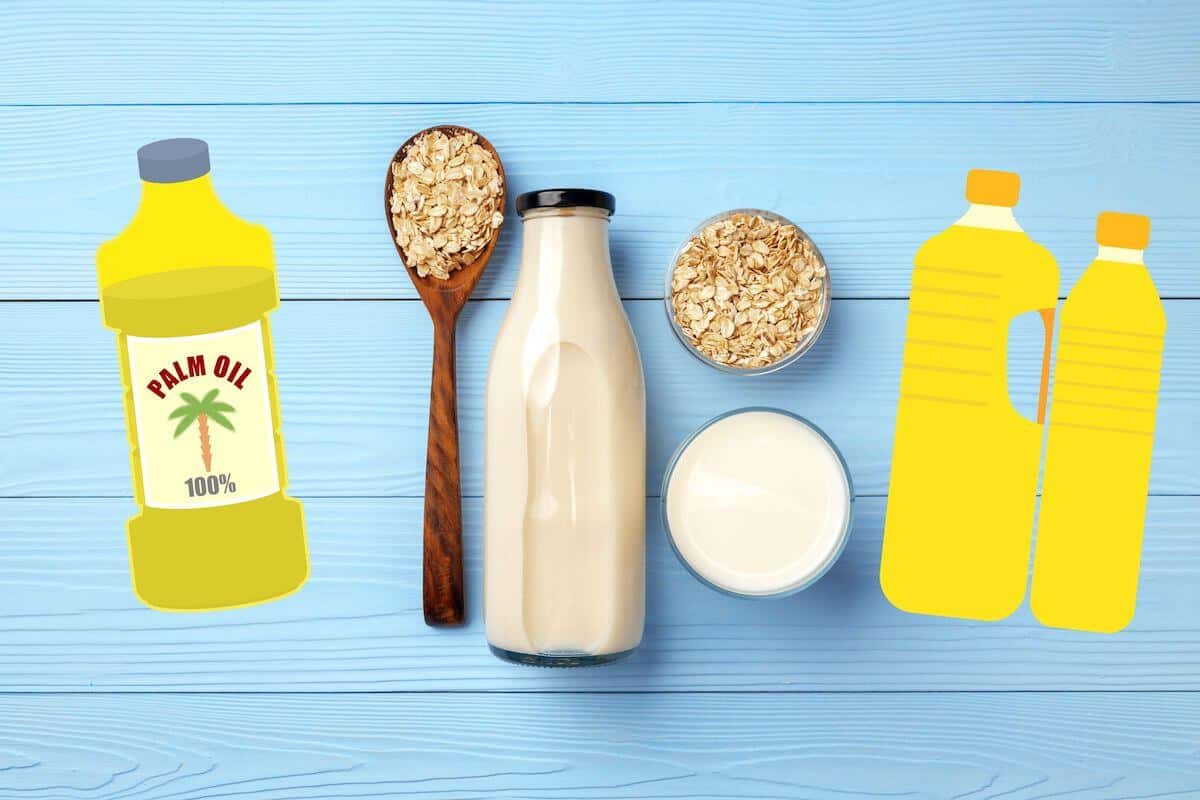Oat milk is created by blending oats and water and straining the mixture to remove the solids. It is generally considered a non-dairy, nut-free, soy-free, plant-based milk alternative that is low in fat and calories and high in fiber. Oat milk is quickly gaining popularity in coffee shops and people’s refrigerators because of its rich flavor and remarkable ability to froth. The good news is it’s so popular that it’s easy to find everywhere now. The not-so-good news is that it froths so well because manufacturers use additives like oil to change the consistency and frothability.
This oil helps with the nutrition of the oat milk by adding a little bit of fat, creating a creamier texture. Some oat milk brands use oil as an emulsifier to help keep the milk from separating and make it froth more like dairy milk. Today we will look at what types of oil are commonly used in oat milk.
What Does The Oil Do?
Some oat milk brands may use a small amount of oil as an emulsifier to help keep the milk from separating and improve its texture and consistency. Emulsifiers help mix two or more ingredients that would otherwise not blend well, such as oil and water.
The oat milk is made by blending oats with water and then straining the mixture. Sometimes, the oat particles will settle at the bottom of the container, which is not pleasant when consumed. To prevent this, oil may be added to help the oat particles remain suspended in the liquid, making smoother, creamier milk.
Natural oat milk (with no additives) will also curdle when heated. Adding fatty oils prevents this from happening. It is important to note that not all oat milk products contain oil, as it’s not a requirement for production.
What Kind Of Oil Is In Oat Milk?
The type of oil used in oat milk can vary depending on the brand and the recipe. Some common types of oil that may be used in oat milk include; sunflower, palm, canola, and rapeseed oil (similar to canola oil).
Sunflower oil is a light-tasting oil high in polyunsaturated fats and vitamin E (source). Palm oil is a semi-solid oil derived from the fruit of the oil palm tree. It is high in saturated fat and a controversial ingredient, often linked with deforestation and human rights violations. Canola oil is also a light-tasting oil that is low in saturated fat and high in monounsaturated fat made from crushed canola seeds. Rapeseed oil comes from the rapeseed plant and has very high levels of erucic acid, which is toxic in large amounts.
It is essential to read the ingredient list of the oat milk product you’re buying to know if oil is in the product and what kind of oil it is, as well as to check for any other ingredients you may have concerns about.

Sunflower Oil In Oat Milk
Sunflower oil is generally considered to be a healthy oil when consumed in moderation. It is high in polyunsaturated fats, which are beneficial for heart health and can help to lower cholesterol levels. It also contains Vitamin E, a powerful antioxidant that can help to protect cells from damage caused by free radicals.
However, not all sunflower oils are the same; cold-pressed sunflower oil contains more beneficial compounds, such as linoleic acid, polyphenols, and phytosterols, than refined sunflower oil. Refined sunflower oil has been through bleaching, deodorizing, and chemical treatment to improve its appearance, flavor, and shelf life. Such a process removes most of the beneficial compounds, meaning that the nutritional value is lower. (source)
It’s important to note that sunflower oil is still high in calories, so it should be consumed in moderation as part of a balanced diet. Also, like most oils, it should be kept away from high heat as it can quickly become rancid and produce harmful compounds.
How Sunflower Oil Is Made
Sunflower oil production involves various stages before it reaches the consumer. To begin, the seeds are cleaned to eliminate any impurities that may have formed. After cleaning, the seeds go through a grinding process, breaking down into smaller pieces. The seeds are then pressed to release their oils more efficiently, and the oil is extracted using hexane as solvent. The final step is refining this oil before packaging.

Canola Oil In Oat Milk
Canola oil is generally considered to be a healthy oil when consumed in moderation. It is low in saturated fat, which is beneficial for heart health, and high in monounsaturated fat, which can also be beneficial for heart health and can help to lower cholesterol levels when eaten with a diet heavy in fruits and vegetables. (source)
It is also a good source of omega-3 fatty acids, which have been shown to have anti-inflammatory properties and may be beneficial for brain health.
However, like sunflower oil, not all canola oils are the same. Cold-pressed canola oil contains more beneficial compounds, such as omega-3s, than refined canola oil. Refined canola oil has been through bleaching, deodorizing, and chemical treatment to improve its appearance, flavor, and shelf life. Such a process removes most of the beneficial compounds, meaning that the nutritional value is lower.
It is important to note that canola oil is still high in calories, so it should be consumed in moderation as part of a balanced diet. Also, like most oils, it should be kept away from high heat as it can quickly become rancid and produce harmful compounds.
It’s also important to note that some people may be sensitive to the form of fatty acid in canola oil called erucic acid. Thus it’s essential to pay attention to how you feel if you consume it.

Palm Oil In Oat Milk
Palm oil is a controversial ingredient, as the large-scale production of palm oil has been linked to deforestation, habitat destruction, and human rights violations. However, when it comes to the health aspects, in moderation, it may have some benefits similar to other oils. It is high in saturated fat, which is a type of fat that can raise cholesterol levels when consumed in excess. Still, it is also a rich source of vitamin E and beta-carotene, which are antioxidants that can help to protect cells from damage caused by free radicals.
It’s fundamental to remember that many of the concerns around palm oil stem from its large-scale production’s environmental and social impacts rather than its nutritional profile. Choosing RSPO (Roundtable on Sustainable Palm Oil) certified palm oil or looking for alternatives like olive, avocado, or coconut oil can be a more sustainable choice.
It’s also worth mentioning that, like other oils, it should be consumed in moderation and kept away from high heat as it can also become rancid and produce harmful compounds.

Rapeseed Oil In Oat Milk
Some oat milk brands may use rapeseed oil as an emulsifier to help keep the milk from separating and improve its texture and consistency.
Rapeseed oil is a vegetable oil that is derived from the seeds of the rape plant. It is high in monounsaturated fats and contains a good balance of omega-3 and omega-6 fatty acids.
Industrial rapeseed oil and culinary canola oil may look the same, but they’re actually different. The canola plant is a genetically modified version of the rapeseed plant.
Rapeseed oil is heavily processed, which often makes the oil unsuitable for human consumption. Extracting oil from seeds is a complex process. High temperatures are often used to get the most yield fast, but this reconfigures the oil’s nutrition and exposes individuals to potentially unhealthy trans fats. In addition, chemicals like hexane may be added for bleaching or deodorizing purposes – introducing toxins into our food ecosystem that could spell trouble down the road if left unchecked. (source)
Rapeseed also has a much higher erucic acid content than canola – so high, in fact that it’s unsuitable for human consumption unless the level of this potentially harmful substance is reduced to 2% or lower with regulated standards. That’s why most varieties at your local grocery store are labeled as ‘canola’ rather than plain old rapeseed. (source)
In the US, canola oil is considered safe due directly to its regulation of erucic acid content, which in high levels, has been linked with heart problems since the 1970s. In other countries, though, these terms remain interchangeable creating confusion about what will be healthier for consumption – especially considering their common usage as an ingredient in oat milk today.
It’s important to note that different brands may have other ingredients and recipes for oat milk. It is advisable to check the ingredient list of the oat milk product you’re buying to confirm whether it contains rapeseed oil. Not all brands include it, and it may be substituted with another type of oil or contain no oil at all.
If you’re looking for oat milk with “safe oil,” Oatly touts its use of non-GMO canola. However, the long-term health impacts remain a subject of controversy and debate.
Oat Milk Without Oils
If the words in this scientific dialogue about canola, rapeseed, and erucic acid are enough to make you wave goodbye to your love of oat milk for good – don’t despair! You’ll be pleased to hear that it’s still possible to find plenty of labels made with nothing but oats, water (and sometimes salt too). Phew- what a relief!!
Here are some examples:
- Willa’s Unsweetened Original Oat Milk
- Elmhurst Unsweetened Oat Milk
- Malibu Mylk Unsweetened Flax + Oat Milk
- Malk Oat Malk
Of course, you can always make homemade oat milk with no oils or emulsifiers! There are a lot of benefits to making homemade oat milk, like getting a bunch of oat pulp to use in smoothies and recipes! Read more about uses for oat pulp here.
Recent Posts
If you are consuming a more plant-based diet, you've likely tried different plant-based milks. Oat and soy milk are among the most popular plant-based milks. Many people use them daily in coffee,...


